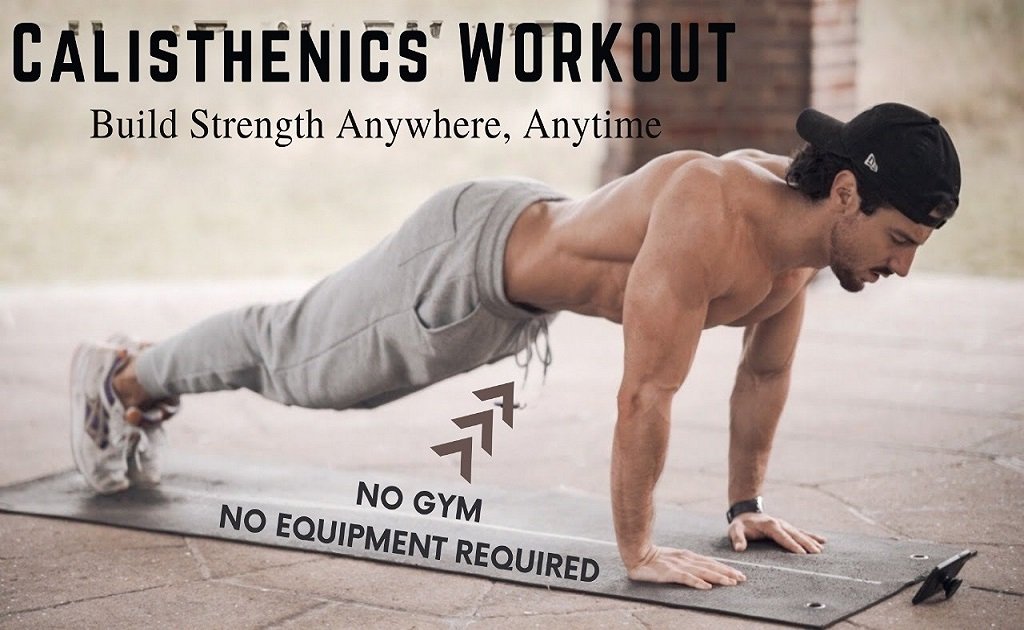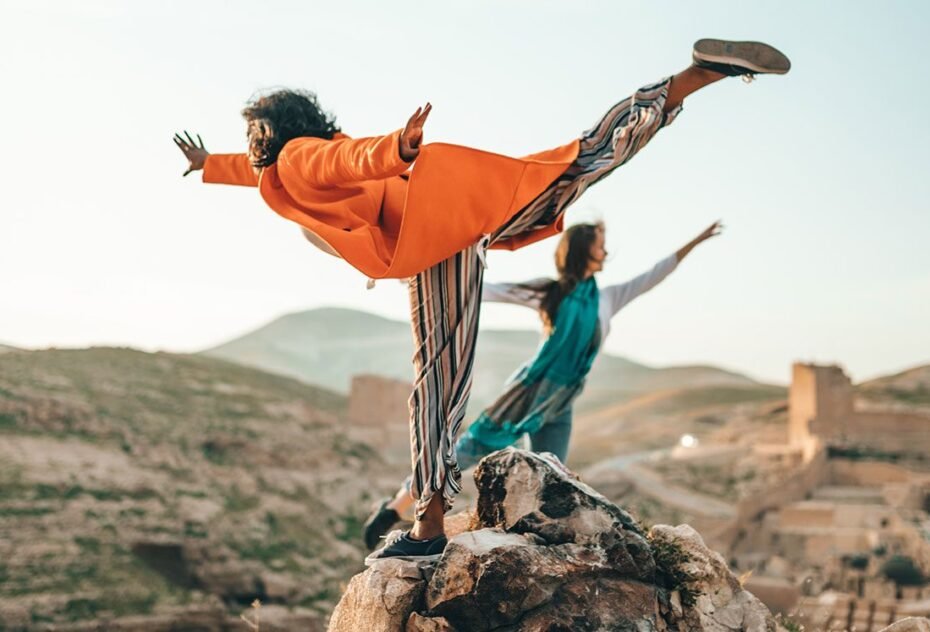The Calisthenics Workout Guide: Build Strength Anywhere, Anytime
- by Usman Nadeem
- 0
- 48

Calisthenics are workout that use your own personal body weight to reduce and make you stronger. They support you in becoming stronger and more flexible, and better able coordinating your movements.
You don’t have to spend a lot of money to start a new training program. You can make big improvements to your body and health with only your body weight when you practice calisthenics (believe me, you can do it!). This kind of workout is great for those who are just starting out and want to become more stronger and more flexible. And it really improves your athletic skills.
One of the worst things about sitting around all the time is that it makes you less flexible. This is bad for your health in the long term, particularly for the stabilizers in your joints. This article provides a month-long workout schedule for calisthenics exercises, a plan about their benefits and health risks, the benefits of exercises, and a fresh point of approach to building long-term strength and energy.
Are you ready to go with the flow? Let’s go into detail about calisthenics workouts.
What is a Calisthenics workout?
“Calisthenics” is the word for “beauty” and “strength.” The idea behind this training method is very simple. Calisthenics workout uses bodyweight and gymnastic-style exercises that use bodyweight and gravity as resistance.
You may have done calisthenics before without even knowing it, even if the idea sounds completely new: Calisthenics workout includes pull-ups, push-ups, and even sit-ups. However, more experienced trainers will try to work the L-sit, muscle-up, handstand push-up, and Planche, to mention a few.
Calisthenics workout is a type of strength training that uses the weight of your own body to fight against gravity. Exercises can be as simple as push-ups and squats or as hard as the Planche and muscle-up.
Benefits of Calisthenics Workout:
Calisthenics workout: A Good Way to Build Muscle Strength
- Calisthenics workouts involve many muscle groups at once, which helps to build muscles in a balanced way and develop functional strength.
- The full range of motion in each exercise increases flexibility and mobility, which reduces the risk of injury and makes daily tasks easier.
- One of the challenges is maintaining your heart healthy, which is very crucial for your long-term health. High-intensity calisthenics can build your heart rate and help you burn more fat, improve your muscle, and get stronger.
- Calisthenics is a type of high-intensity interval training (HIIT), which effectively makes it a good method to reduce weight and burn calories.
- After a workout, the release of endorphins is crucial for mental health by fighting stress and anxiety.
- You can conduct it anywhere, even indoors, outdoors, or while traveling, thanks to its flexibility.
Calisthenics Workout for Beginners
Don’t expect to be able to do handstand push-ups on the floor right away. It’s very important to learn the basics of calisthenics before you start doing them. These beginner “calisthenics workout” work on four main areas:
- Strength to push
- Strength to pull
- Strength in the lower body
- Strength in the core
These calisthenics workout make up a basic calisthenics workout that builds strength, control, and body awareness so you can move on to harder calisthenics workout.
You should know that you can make each of these exercises easier or harder, depending on how fit you are right now.
1. Pushups
In this workout, you elevate your body with your arms straight from your head to your heel. You should concentrate on your chest, shoulders, and triceps. In a high position, the arms may be completely extended, and in a low position, they can be almost fully flexed, but they should not touch the floor. They also teach how to stabilize and regulate your body, which is an important skill for all calisthenics moves, especially as they become harder.
- Start in a high plank posture with your hands wider than your shoulders and your body in a straight line.
- Engage your shoulder blades and tighten your thighs and core muscles.
- Look at the floor.
- Bend your elbows so that they are at a 45° angle and your arms are parallel to the floor.
- Keep your elbow close to your side and engage your thigh muscles.
- Keep your nose, chest, and belly button at the same level.
- Take a rest and put your hands on the floor.
- Do the exercise again.
2. Pull-ups:
Hold the bar with your hands shoulder-width apart during a pull-up. The person lifts their body so that their chin is parallel to the bar. All the time, they keep their backs straight. The person comes back to the first position slowly and calmly. Legs are the main muscles that work properly, but the main job is done by their upper back, wrists, and core muscles.
Try to do 10 tight pull-ups as part of your starting calisthenics workout.
- Use a box or jump up to the bar.
- Hold the bar with an overhand grip, with your fingertips facing upward and your hands shoulder-width apart.
- If you are standing on a box, step down with your arms out and your shoulders slightly bent.
- To pull up to the bar, push your elbows back and down.
- Pull your chest up toward the bar until your chin is above it.
- Stop at the top, then go down, keeping control of the drop until you are fully hanging.
“If doing a full pull-up is too hard, try a scaled version, like ring rows, to build strength.” Begin with your body more upright, then each session, move your feet out a little bit until you can do the complete set while lying virtually flat.
3. Squats:
Squats are a type of calisthenics that you can do in a lot of different ways. To do them, stand with your feet shoulder-width apart, squat down until your thighs are parallel to the floor, and then stand back up. They work out the core, glutes, calves, hamstrings, and quadriceps. You can change the height of the squat depending on how fit you are. Squats are one of the most versatile exercises because they are easy to do in most places and don’t take up much space.
- Stand tall with your feet shoulder-width apart.
- Keep your chest up and your core engaged.
- Bend your knees and lower your hips like a chair.
- Lower your thighs so they are parallel to the floor, and keep your heels on the ground.
- Push through your heels to get back up, squeezing your glutes.
While you squat, act like you’re pulling the floor apart with your feet. Push your feet outwards as if you’re trying to tear the ground between them. This gets your legs working, keeps your knees in line, and makes you more stable.
4. Dips:
Strict bar dips are an important exercise for building the strength, stability, and control you need to push. They strengthen the chest, shoulders, and triceps, which are important for calisthenics moves like muscle-ups and Planche. These dips are also the first step toward more difficult calisthenics moves like muscle-ups, front lever, and handstand push-ups, which help you learn how to control your body in deep positions. If you want to do any of these movements, you need to be able to do them perfectly.
A Look at the Parallel Bar Exercise
- Jump up with straight arms and locked elbows.
- Hold the parallel bars with an overhand grip.
- Keep your body straight and your core tight.
- Keep your sides close and slowly lower your elbows to 90°.
- Stop for a moment at the bottom, then push back up.
- Do the reps again, making sure to keep good form and control.
Use a resistance band to make your body weight less when you do dips. Put the band over a straight bar, hold one end, and dip with both knees. The thicker the band, the more help it gives. As you get stronger, you should slowly make it thinner.
5. Planks:
Core strength is what makes calisthenics movements stable, controlled, balanced, and able to transfer energy efficiently. The plank is a great way to build core strength and balance because it works the deep core muscles that are important for stability and control in many calisthenics movements. It also teaches how to brace and align correctly, which makes it an important exercise for beginners.
- Extend legs and balance on toes. Begin with flat forearms and elbows beneath shoulders.
- Pulling the belly button toward the spine will engage the core.
- Keep your body straight from head to heels.
- Hold the position for 20–60 seconds while breathing steadily.
To get the core and surrounding muscles going, try different plank variations like high planks on your elbows or side planks. Traditional planks work the right abdominis and parallel abdominis, while side planks work the obliques more. Changing up your planks will make sure you work out all the parts of your core.
6. Crunches:
A typical abdominal exercise that works the rectus abdominis muscle is the crunch. Lay flat on your back with your feet flat on the floor and your knees bent to perform a basic crunch. Pull your belly button in the direction of your spine to activate your core. When you breathe out, raise your shoulders and upper back off the ground. When you inhale, slowly lower your back down.
- Place your feet flat on the ground with your knees bent at a 90-degree angle.
- Lay flat on your back.
- Place your hands behind your head and keep your head a fist’s distance from your chest.
- Sit up until your knees are touched by your elbows or chest.
- When lifting, concentrate on your core muscles.
- While lying down, exhale and inhale.
To avoid stress, concentrate on moving with control and keep your lower back pressed into the floor. Enhance posture, core stability, and ab strength. No special equipment is required. Weighted crunches, bicycle crunches, and reverse crunches are some variations.
7. Burpees:
Burpees are a type of bodyweight exercise that simultaneously works your cardiovascular system and multiple muscles.
A full-body calisthenics workout that targets the arms, legs, chest, abdominal muscles, and various back muscles. After lowering themselves into a squat, the participant rapidly raises their arms and legs into a push-up position. Before completing their rep, some people jump up and tuck their legs in for a push-up, which is optional.
- Maintain your weight in your heels and your arms by your sides as you face forward with your feet shoulder-width apart.
- Lower yourself into a squat by pushing your hips back and bending your knees.
- Place your hands palm-down on the floor in front of you, keeping them slightly narrower than your feet.
- With your body in a straight plank position, place your weight in your hands and jump your feet back, landing gently on the balls of your feet.
- Make sure your back doesn’t sag or protrude into the air.
- Leap your feet forward until they touch your hands.
- Leap swiftly into the air and raise your arms above your head.
A 30-Day Workout Plan for Beginners Using Calisthenics
Week 1: The base of the building
Day 1: Full Body Workout
• Push-ups, squats, plank, jumping jacks.
Day 2: Upper Body Focus
• Pull-ups, triceps, dips, shoulder taps.
Day 3: Lower Body Focus
• Lunges, glute bridges, calves Raises.
Day 4: Rest and Recovery
Day 5: Core Strength
•Sit-ups, Russian twists, leg exercises.
Day 6: Cardio and Flexibility
• Burpees, high knees, static stretching.
Day 7: Rest and Reflection.
Week 2: Getting More Intense
Day 1: Full Body Workout:
•Push-ups, squats, plank, and jumping jacks.
Day 2: Upper Body Focus
• Pull-ups, triceps, dips, and shoulder taps.
Day 3: Focus on the Lower Body
• Lunges, glute bridges, and calves.
Day 4: Rest and heal
• Core Strength • Russian twists, sit-ups, and leg exercises.
Day 6: Flexibility and Cardio
• Burpees, high knees, and static stretching.
Day 7: Take a break and think.
Week 3: Getting the Hang of It
Day 1: Complete Body Workout:
•Jumping jacks, planks, squats, and push-ups.
Day 2: Emphasis on the Upper Body:
•Shoulder taps, triceps dips, and pull-ups.
Day 3: Focus on the Lower Body:
•Calves, glute bridges, and lunges.
Day 4: Recuperation and Rest
• 25 minutes of static stretching.
Day 7: Relaxation and Introspection
Week Four: Overview of the Workout
Day 1: Complete Body Workout: Jumping Jacks, Planks, Squats, and Push-Ups.
Day 2: Focus on the Upper Body: Shoulder taps, triceps dips, and pull-ups.
Day 3: Focus on the Lower Body: calves, glute bridges, and lunges.
FAQs
1. How to start calisthenics as a beginner?
As a beginner, you should concentrate on getting your form right on compound exercises like push-ups, squats, and planks. Do a few reps to start, and then keep going until you get stronger. Keep practicing and be consistent. To avoid getting hurt, always do dynamic stretches or skip before you work out.
2. What are the basic exercises for calisthenics?
Some of the most basic calisthenics exercises are:
- Push-ups are a good way to work out your chest, shoulders, and triceps.
- Squats work your hamstrings, quads, glutes, and calves.
- Planks are a great way to strengthen and stabilize your core.
- Pull-ups are a great way to build strength in your back and upper body, as well as your shoulder stabilizers.
- Lunges improve your coordination and flexibility while also making your legs stronger.
3. Can you build muscle with calisthenics?
Yes! Calisthenics uses progressive overload with harder variations, greater number of sets, and more resistance to build muscle and strength.
4. Is calisthenics good for weight loss?
Absolutely. It helps with long-term fat loss by increasing metabolism, burning calories, and gaining lean muscle mass.
5. How long does it take to see results with calisthenics workout?
After 4–6 weeks of consistent use this exercise most people see improvements in strength and stamina. Depending on diet and training intensity, it might take a little longer to see noticeable muscle growth.
Final Thoughts
One of the best and most sustainable ways to increase power, stamina, and fitness without the need for equipment is through calisthenics. Bodyweight exercises allow you to work out anywhere, whether you’re training indoors or outdoors.
Start with simple calisthenics workout, maintain consistency, and observe how your body changes on its own.





